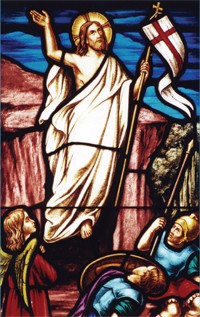As Catholics, we believe that on Easter, Jesus Christ rose body and soul from the tomb as the Glorious Victor over sin and death. Christ’s triumph is also a cherished promise for all of us. It is our assurance that the bodies of all who were united to Christ in this life through Sacramental regeneration will one day rise to take their place with Him when He comes to bring a new heaven and a new earth. The experience of death inevitably brings deep sadness, because it separates us from our loved ones, but when we walk with Christ, it is also full of hope. His Church understands death, and she knows the resurrection. As they have throughout the centuries, the Church’s rites accompany our loved ones into the next world, and are a promise of hope for those of us who await our own encounter with the mystery of death.

Preparation for Death
We know that our earthly existence will come to an end. However, for most of our lives, we do not know the day or the hour when we will be called from this life. When the time of death seems to be drawing near, the Church has special rites to prepare us to come before the Lord. Whenever it appears that someone has a serious illness, it is appropriate to contact a priest to receive the anointing of the sick, by which the Church asks the Lord to grant healing of soul and body. This is often preceded by thesacrament of reconciliation, where Christ offers the forgiveness of sins. As an individual confronts illness, the Church assures them of Christ’s presence by providing opportunities to receive Holy Communion, so that their suffering might acquire meaning from the power of Christ’s cross. When the moment of death draws near, Holy Communion is given as viaticum, the “food for the journey,” so that Christ, present in the Blessed Sacrament, might bring spiritual strength for the passage into new life. Finally, at the hour of death, a priest or deacon may accompany the dying and their family with prayers asking God’s grace for a person about to set foot into eternity.
The Catholic Funeral
As human beings, we have an intense need to say goodbye to our loved ones and to commend them to God. The Church’s rites reflect that need, as her prayers accompany the deceased beyond this life. There are three parts to a Catholic funeral. First, there is a vigil service, which typically takes place the night before the funeral. Here, family and friends gather to “be with” and “watch over” the body of the deceased. In addition to the formal liturgical rites of the Church, the vigil may be an opportunity to pray the rosary or to speak lovingly in memory of the departed. It also allows well-wishers to offer their condolences to the family. The vigil may take place in a funeral parlor, at the family’s home, or in the church.
The focus of the Church’s prayers for the departed is the funeral mass. Here, the body of the deceased is brought to the church, where the celebration of the Eucharist reveals the presence of Christ’s own passion, death, and resurrection. Just as the deceased was welcomed into Christ’s family through baptism and nourished in the Church through the sacraments, so now their body is brought to the church a final time as the Church prays for the gift of eternal life. If special circumstances require it, a funeral can also be celebrated outside of mass.
We believe that the body itself is sacred, the physical substance of a person that will rise on the last day when Christ comes with new heavens and a new earth. For this reason, in the Rite of Committal, the Church commends the body of the deceased to the earth, to keep it until the day of the resurrection.
Remembering the Dead
After the burial, we do not forget our loved ones. Indeed, we need to remember and to pray for them. For this reason, it is customary to visit the graves of the deceased, frequently to remember them in prayer, and to request that masses be offered for the repose of their souls, especially on important anniversaries such as one month or one year from the date of their death or the anniversaries of their birth. In addition to special masses, the Church prays for all deceased Christians on All Souls’ Day.
What about Cremation?
Although cremation in the United States of America was in the past closely associated with opinions that rejected our faith in the resurrection of the body, the Church no longer prohibits it, so long as it is not used as a sign of disrespect for the dead or a denial of the bodily resurrection. If cremation is chosen, it should ordinarily take place following the funeral mass, and the cremated remains are then entombed or buried in the same dignified way that the body would be. Respect for the body requires that the cremated remains be treated with the same respect after cremation that the body deserves. The Church also permits the celebration of the funeral Mass in the presence of the cremated remains and that is possible here in the Archdiocese of Atlanta. Here again, the cremated remains must always be honored with the same reverence and respect that is their due as the residual elements of the human body that itself was sanctified and recognized through the sacraments.

